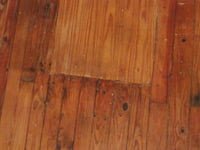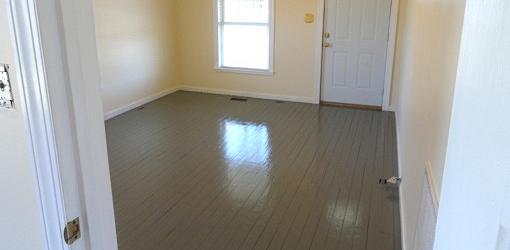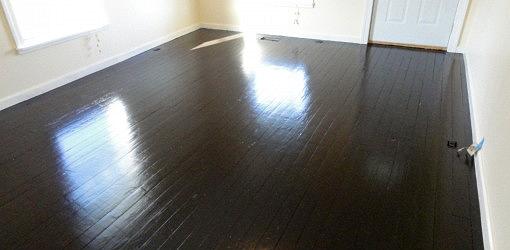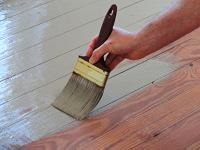How to Get Rid of Acrylic Paint on Wood

This summer, I committed what any self-respecting lover of natural building materials would call a cardinal sin. I walked into our old farmhouse with nearly 100-year-old pine floors, and when my husband asked what we should do with them, I replied, "Paint 'em."
Yes, you heard me – paint them! He gave me the same look you're giving me now. But in this case, a nice coat of paint would be just the thing to hide the scars, pits, and patches; and fill in the cracks and seal up this rickety old floor.

Painting would also save the backbreaking labor and expense of refinishing, not to mention the disappointment when they inevitably ended up still looking like beat up old floors. It was a winning proposition from all directions. And, it turned out beautifully.
We kept it simple, choosing a glossy paint that would give a sleek, clean look. We started with a mossy green, but that turned out not to conceal the flaws as much as we wanted, so we recoated it with an almost black color.
That's the cool thing about painted floors – you can change the color, and there's no end to the creativity! You can:
- Use painter's tape or stencils to make checkerboard and geometric patterns, stripes, designs, and motifs.
- Set off areas of the room using painted faux "throw rugs" or borders.
- Brighten up dark spaces, or anchor bright spaces.
- Give new, vibrant life to old floors at a fraction of the cost of replacing or refinishing.

Painting floors is not effortless, especially if the wood already has a finish on it. If you want the new paint to stick, there's a good bit of prep involved, and several steps:
Floor Painting Planning
This is a project that requires some advance planning. Naturally, you'll need to move all the furniture out of the area, and you won't want to sleep in the house until the fumes dissipate. You'll also need dry weather for the paint to cure properly before moving back in, as humidity will keep it tacky.
We painted our floors and then left town for about a week. When we came home, they were dry enough to move in; but it was several weeks before the smell was completely gone.

Choosing Your Paint
For best results, go with a standard oil-based porch and floor paint or oil-based enamel. These aren't exactly the greenest products on the market, but they'll stand up to foot traffic better than any other paint. Other types of paints offer a tradeoff – they'll have less fumes, but they won't be as durable.
No matter what paint you choose, consider wearing a respirator! And, while you'll get the best results if you seal the doorways with plastic to keep out dust, we found that the fumes were so overpowering that we couldn't handle being in there without the windows open and ceiling fans running the whole time.
How To Paint Wood Floors
Make sure your floor hasn't been waxed before painting, and remove the wax if it has. Follow these steps when painting a floor:
-
- Step 1: Rough Surface: Using a square pad sander (or by hand), rough up the finish on the floor with 150-grit sandpaper. You don't need to completely sand them, just remove the gloss from the old finish.
- Step 2: Clean Floor: Thoroughly vacuum and damp-mop the floors, to remove all the dust. Allow them to dry completely.

- Step 3: Apply First Coat: Using a brush or roller, apply the first thin coat of floor paint. A brush will give a smoother finish, but a roller is faster. Resist the urge to glop on the paint – it won't dry! Start by cutting in the edges with a brush, then use a brush or roller to work your way towards the door so you aren't painted into a corner. Allow the paint to dry for 24-48 hours, until it's dry enough to walk on.
- Step 4: Smooth Paint: Lightly go over the floor with 220-grit sandpaper, to smooth out the grain and give a sleek surface, then clean the floor to remove all the dust.
- Step 5: Apply Second Coat: Apply a second thin coat in the same manner. Paint your way towards the door, then get yourself out of those fumes! Some paints may require up to three coats.
- Step 6: Decorative Touch: After your base coat is good and dry, you can add stripes, motifs, or other designs. Use safe release painter's tape so it won't pull up the base coats.
- Step 7: Seal Floor (Optional): For high-traffic areas, you may want to coat the finished floors with a clear polyurethane.
- Step 8: Let Paint Cure: Within a few days, you should be able to walk gently on the floors, but it will be several weeks before the paint is fully cured and the smell goes away.
Further Information
Check out these inspiring articles for painted floor ideas:
- Painted Wood Floors (thingsthatinspire.net)
- Painting Wood Floors (yourhomeonlybetter.com)
- How to Paint a Wood Floor (This Old House)
How to Get Rid of Acrylic Paint on Wood
Source: https://todayshomeowner.com/painting-wood-floors/
0 Response to "How to Get Rid of Acrylic Paint on Wood"
Post a Comment